C++ 智能指针详解
智能指针总结
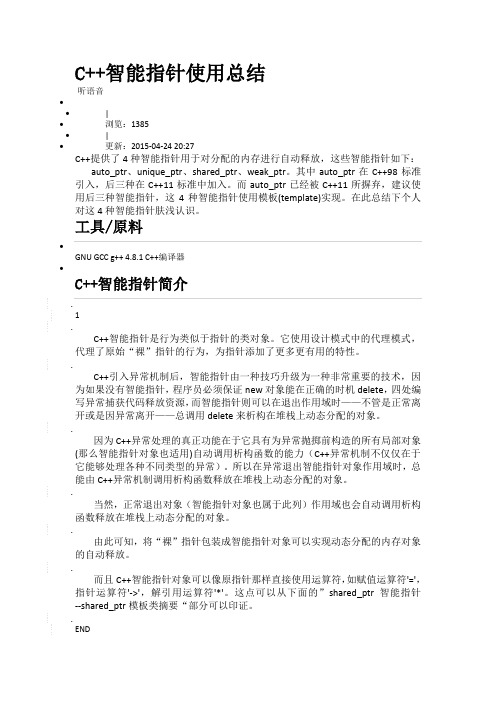
C++智能指针使用总结听语音∙∙|∙浏览:1385∙|∙更新:2015-04-24 20:27C++提供了4种智能指针用于对分配的内存进行自动释放,这些智能指针如下:auto_ptr、unique_ptr、shared_ptr、weak_ptr。
其中auto_ptr在C++98标准引入,后三种在C++11标准中加入。
而auto_ptr已经被C++11所摒弃,建议使用后三种智能指针,这4种智能指针使用模板(template)实现。
在此总结下个人对这4种智能指针肤浅认识。
工具/原料∙GNU GCC g++ 4.8.1 C++编译器∙C++智能指针简介.1.C++智能指针是行为类似于指针的类对象。
它使用设计模式中的代理模式,代理了原始“裸”指针的行为,为指针添加了更多更有用的特性。
.C++引入异常机制后,智能指针由一种技巧升级为一种非常重要的技术,因为如果没有智能指针,程序员必须保证new对象能在正确的时机delete,四处编写异常捕获代码释放资源,而智能指针则可以在退出作用域时——不管是正常离开或是因异常离开——总调用delete来析构在堆栈上动态分配的对象。
.因为C++异常处理的真正功能在于它具有为异常抛掷前构造的所有局部对象(那么智能指针对象也适用)自动调用析构函数的能力(C++异常机制不仅仅在于它能够处理各种不同类型的异常)。
所以在异常退出智能指针对象作用域时,总能由C++异常机制调用析构函数释放在堆栈上动态分配的对象。
.当然,正常退出对象(智能指针对象也属于此列)作用域也会自动调用析构函数释放在堆栈上动态分配的对象。
.由此可知,将“裸”指针包装成智能指针对象可以实现动态分配的内存对象的自动释放。
.而且C++智能指针对象可以像原指针那样直接使用运算符,如赋值运算符'=',指针运算符'->',解引用运算符'*'。
这点可以从下面的”shared_ptr智能指针--shared_ptr模板类摘要“部分可以印证。
C++标准库智能指针
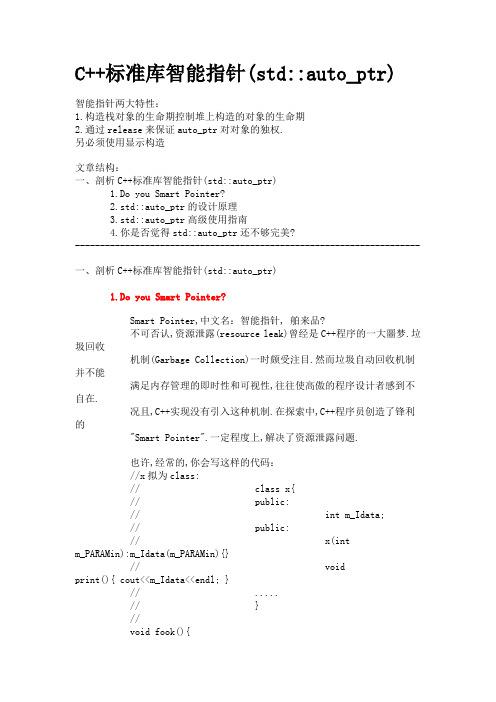
C++标准库智能指针(std::auto_ptr)智能指针两大特性:1.构造栈对象的生命期控制堆上构造的对象的生命期2.通过release来保证auto_ptr对对象的独权.另必须使用显示构造文章结构:一、剖析C++标准库智能指针(std::auto_ptr)1.Do you Smart Pointer?2.std::auto_ptr的设计原理3.std::auto_ptr高级使用指南4.你是否觉得std::auto_ptr还不够完美?---------------------------------------------------------------------一、剖析C++标准库智能指针(std::auto_ptr)1.Do you Smart Pointer?Smart Pointer,中文名:智能指针, 舶来品?不可否认,资源泄露(resource leak)曾经是C++程序的一大噩梦.垃圾回收机制(Garbage Collection)一时颇受注目.然而垃圾自动回收机制并不能满足内存管理的即时性和可视性,往往使高傲的程序设计者感到不自在.况且,C++实现没有引入这种机制.在探索中,C++程序员创造了锋利的"Smart Pointer".一定程度上,解决了资源泄露问题.也许,经常的,你会写这样的代码://x拟为class:// class x{// public:// int m_Idata;// public:// x(int m_PARAMin):m_Idata(m_PARAMin){}// void print(){ cout<<m_Idata<<endl; }// .....// }//void fook(){x* m_PTRx = new A(m_PARAMin);m_PTRx->DoSomething(); //#2delete m_PTRx;}是的,这里可能没什么问题.可在复杂、N行、m_PTRclassobj所指对象生命周期要求较长的情况下,你能保证你不会忘记delete m_PTRclassobj吗?生活中,我们往往不应该有太多的口头保证,我们需要做些真正有用的东西.还有一个更敏感的问题:异常.假如在#2方法执行期异常发生,函数执行终止,那么new出的对象就会泄露.于是,你可能会说:那么就捕获异常来保证安全性好了.你写这样的程式:void fook(){A* m_PTRx = new A(m_PARAMin);try{m_PTRx->DoSomething();}catch(..){delete m_PTRx;throw;}delete m_PTRx;}哦!天哪!想象一下,你的系统,是否会象专为捕获异常而设计的.一天,有人给你建议:"用Smart Pointer,那很安全.".你可以这样重写你的程序:void fook(){auto_ptr<x> m_SMPTRx(new x(m_PARAMin));m_SMPTRx->DoSomething();}OK!你不太相信.不用delete吗?是的.不用整天提心吊胆的问自己:"我全部delete了吗?",而且比你的delete策略更安全.然后,还有人告诉你,可以这样用呢:ok1.auto_ptr<x> m_SMPTR1(new x(m_PARAMin));auto_ptr<x> m_SMPTR2(m_SMPTR1); //#2May be you can code #2 like this :auto_ptr<x> m_SMPTR2;m_SMPTR2 = m_SMPTR1;ok2.auto_ptr<int> m_SMPTR1(new int(32));ok3.auto_ptr<int> m_SMPTR1;m_SMPTR1 = auto_ptr<int>(new int(100));也可以:auto_ptr<int> m_SMPTR1(auto_ptr<int>(new int(100)));ok4.auto_ptr<x> m_SMPTR1(new x(m_PARAMin));m_SMPTR1.reset(new x(m_PARAMin1));ok5.auto_ptr<x> m_SMPTR1(new x(m_PARAMin));auto_ptr<x> m_SMPTR2(m_SMPTR.release());cout<<(*m_SMPTR2).m_Idata<<endl;ok6.auto_ptr<int> fook(){return auto<int>(new int(100));}ok7.............and so on但不可这样用:no1.char* chrarray = new char[100];strcpy(chrarray,"I am programming.");auto_ptr<char*> m_SMPTRchrptr(chrarray);//auto_ptr并不可帮你管理数组资源no2.vector<auto_ptr<x>> m_VECsmptr;m_VECsmptr.push_back(auto_ptr<int>(new int(100)));//auto_ptr并不适合STL内容.no3.const auto_ptr<x> m_SMPTR1(new x(100));//所有权问题,不能用const 类型auto_ptr<x> m_SMPTR(new x(200));no4.x m_OBJx(300);auto_ptr<x> m_SMPTR(&m_OBJx);//不支持栈资源的释放,因为析构中用的是deleteno5x* m_PTR = new x(100);auto_ptr<x> m_SMPTR = m_pTR;//禁止隐式转换no6..........and so on预先提及所有权的问题,以便下面带着疑问剖析代码?power1.auto_ptr<x> m_SMPTR1(new x(100));auto_ptr<x> m_SMPTR2 = m_SMPTR1;m_SMPTR2->print();//输出:100.m_SMPTR1->print();//!! 非法的.power2.auto_ptr<x> m_SMPTR(new x(100));auto_ptr<x> returnfun(auto_ptr<x> m_SMPTRin){return m_SMPTRin;}auto_ptr<x> = returnfun(m_SMPTR); //#5//在上面的#5中,我要告诉你对象所有权转移了两次.//什么叫对象所有权呢?2. std::auto_ptr的设计原理上面的一片正确用法,它们在干些什么?一片非法,它们犯了什么罪?一片什么所有权转移,它的内部机智是什么?哦!一头雾水?下面我们就来剖析其实现机制.基础知识:a.智能指针的关键技术:在于构造栈上对象的生命期控制堆上构造的对象的生命期.因为在智能指针的内部,存储着堆对象的指针,而且在构析函数中调用delete行为.大致机构如下:x* m_PTRx = new x(100);//#1template<typename T>auto_ptr{private:T* m_PTR;//维护指向堆对象的指针,在auto_ptr定位后.... //它应该指向#1构造的对象,即拥有所有权.~auto(){ delete m_PTR; }....}b.所有权转移之说上面曾有一非法的程式片段如下:auto_ptr<x> m_SMPTR1(new x(100));auto_ptr<x> m_SMPTR2 = m_SMPTR1;m_SMPTR2->print();//输出:100.m_SMPTR1->print();//!! 非法的.按常理来说,m_SMPTR->print();怎么是非法的呢?那是因为本来,m_SMPTR1维护指向new x(100)的指针,可是m_SMPTR2 = m_SMPTR1;auto_ptr内部机制使得m_SMPTR1将对象的地址传给m_SMPTR2,而将自己的对象指针置为0.那么自然m_SMPTR->print();失败.这里程序设计者要负明显的职责的.那么auto_ptr为什么采取这样的策略:保证所有权的单一性.亦保证了系统安全性.如果多个有全权的auto_ptr维护一个对象,那么在你消除一个 auto_ptr时,将导致多个auto_ptr的潜在危险.下面我们以SGI-STL的auto_ptr设计为样本(去掉了无关分析的宏),来剖析其原理.#1 template <class _Tp> class auto_ptr {#2 private:#3 _Tp* _M_ptr; //定义将维护堆对象的指针#4 public:#5 typedef _Tp element_type; //相关类型定义#6 explicit auto_ptr(_Tp* __p = 0) __STL_NOTHROW : _M_ptr(__p) {}#7 auto_ptr(auto_ptr& __a) __STL_NOTHROW : _M_ptr(__a.release()) {}#8 template <class _Tp1> auto_ptr(auto_ptr<_Tp1>& __a)__STL_NOTHROW:_M_ptr(__a.release()) {}//#6、#7、#8是auto_ptr构造函数的三个版本.//#6注释:传入对象的指针,构造auto_ptr.explicit关键字:禁止隐式转换.// 这就是ok2正确,而no5(隐式转换)错误的原因.//#7注释:拷贝构造函数.// 传入auto_ptr实例,构造auto_ptr. ok1、ok3使用了这个构造式.// 它是一个很关键的构造函数,在具体情况下,我们再分析 //#8注释:auto_ptr的模板成员,可在继承对象重载的基础上,实现特殊功能.//// 举例:// class A{ public:// virtual void fook(){cout<<"I am programming"<<endl;// /*..........*/ };// class B : public A {// virtual void fook(){ cout<<"I am working"<<endl; // /*...........*/ };// auto_ptr<A> m_SMPTRa(new A(33));//实质:// auto_ptr<B> m_SMPTRb(m_SMPTRa); //基类的指针可以赋给派生类的指针//// auto_ptr<B> m_SMPTRb(new B(44));//实质:// auto_ptr<A> m_SMPTRa(m_SMPTRb); //派生类的指针不可赋给基类的指针//// auto_ptr<A> m_SMPTRa(new B(33)); // ok!// m_SMPTRa->fook()将调用派生类B的fook()// m_SMPTRa->A::fook()将调用基类A的fook()//// auto_ptr<B> m_SMPTRb(new A(33)); // wrong!////#9 auto_ptr& operator=(auto_ptr& __a) __STL_NOTHROW {#10 if (&__a != this) { delete _M_ptr; _M_ptr = __a.release(); } #11 return *this;#12 }#13 template <class _Tp1>#14 auto_ptr& operator=(auto_ptr<_Tp1>& __a) __STL_NOTHROW { #15 if (__a.get() != this->get()) { delete _M_ptr; _M_ptr =__a.release(); }#16 return *this;#16 }//// #9~~#16 两个版本的指派函数.// delete _M_ptr; 在指派前,销毁原维护的对象.// _a.release() ; release操作,详细代码参见#20~~#23. // 用于*this获得被指派对象,// 且将原维护auto_ptr置空.// no3使用了第一种指派.// 而权限转移正是_a.release()的结果.#17 ~auto_ptr() __STL_NOTHROW { delete _M_ptr; }//构析函数.消除对象.注意这里对对象的要求!#17 _Tp& operator*() const __STL_NOTHROW { return *_M_ptr; } #18 _Tp* operator->() const __STL_NOTHROW { return _M_ptr; } #19 _Tp* get() const __STL_NOTHROW { return _M_ptr; }//// 操作符重载.// #17注释:提领操作(dereference),获得对象. 见ok5用法.// #18注释:成员运算符重载,返回对象指针.// #19注释:普通成员函数.作用同于重载->运算符//#20 _Tp* release() __STL_NOTHROW {#21 _Tp* __tmp = _M_ptr;#22 _M_ptr = 0;#23 return __tmp; }//上面已经详解#24 void reset(_Tp* __p = 0) __STL_NOTHROW {#25 delete _M_ptr;#26 _M_ptr = __p; }////传入对象指针,改变auto_ptr维护的对象// 且迫使auto_ptr消除原来维护的对象// 见ok3用法.// According to the C++ standard, these conversions are required. Most// present-day compilers, however, do not enforce that requirement---and,// in fact, most present-day compilers do not support the language// features that these conversions rely on.//下面这片段用于类型转化,目前没有任何编译器支持//具体技术细节不诉.#ifdef __SGI_STL_USE_AUTO_PTR_CONVERSIONS#27 private:#28 template<class _Tp1>#29 struct auto_ptr_ref { _Tp1* _M_ptr; auto_ptr_ref(_Tp1* __p) : _M_ptr(__p) {}};#30 public:#31 auto_ptr(auto_ptr_ref<_Tp> __ref) __STL_NOTHROW: _M_ptr(__ref._M_ptr) {}#32 template <class _Tp1>#33 operator auto_ptr_ref<_Tp1>() __STL_NOTHROW#34 { return auto_ptr_ref<_Tp>(this->release()); }#35 template <class _Tp1> operator auto_ptr<_Tp1>() __STL_NOTHROW #36 { return auto_ptr<_Tp1>(this->release()); }#37 #endif /* __SGI_STL_USE_AUTO_PTR_CONVERSIONS */#38 };OK!就是这样了.正如上面原理介绍处叙说,你需要正视两大特性:1.构造栈对象的生命期控制堆上构造的对象的生命期2.通过release来保证auto_ptr对对象的独权.在我们对源码分析的基础上,重点看看:no系列错误在何处?no1.我们看到构析函数template<class _Tp>~auto_ptr() _STL_NOTHROW{ delete _M_ptr; }所以它不能维护数组,维护数组需要操作:delete[] _M_ptr;no2.先提部分vector和auto_ptr代码:a.提auto_ptr代码auto_ptr(auto_ptr& __a) __STL_NOTHROW : _M_ptr(__a.release()) {} b.提vector代码Part1:void push_back(const _Tp& __x) {if (_M_finish != _M_end_of_storage) {construct(_M_finish, __x);++_M_finish;}else_M_insert_aux(end(), __x);}Part2:template <class _T1, class _T2>inline void construct(_T1* __p,//++++++++++++++++++++++++++++++++// const _T2& __value) { +//++++++++++++++++++++++++++++++++// new (__p) _T1(__value); +//++++++++++++++++++++++++++++++++}Part3.template <class _Tp, class _Alloc>voidvector<_Tp, _Alloc>::_M_insert_aux(iterator __position,//++++++++++++++++++++++++++++++++// const _Tp& __x) ++//++++++++++++++++++++++++++++++++{if (_M_finish != _M_end_of_storage) {construct(_M_finish, *(_M_finish - 1));++_M_finish;//++++++++++++++++++++++++++++++++// _Tp __x_copy = __x; +//++++++++++++++++++++++++++++++++copy_backward(__position, _M_finish - 2, _M_finish - 1); *__position = __x_copy;}else {const size_type __old_size = size();const size_type __len = __old_size != 0 ? 2 * __old_size : 1; iterator __new_start = _M_allocate(__len);iterator __new_finish = __new_start;__STL_TRY {__new_finish = uninitialized_copy(_M_start, __position, __new_start);construct(__new_finish, __x);++__new_finish;__new_finish = uninitialized_copy(__position, _M_finish, __new_finish);}__STL_UNWIND((destroy(__new_start,__new_finish),_M_deallocate(__new_start,__len)));destroy(begin(), end());_M_deallocate(_M_start, _M_end_of_storage - _M_start);_M_start = __new_start;_M_finish = __new_finish;_M_end_of_storage = __new_start + __len;}}从提取的vector代码,Part1可看出,push_back的操作行为.兵分两路,可是再向下看,你会发现,无一例外,都通过const _Tp& 进行拷贝行为,那么从auto_ptr提出的片段就派上用场了.可你知道的,auto_ptr总是坚持对对象的独权.那必须修改原来维护的对象,而vector行为要求const _Tp&,这样自然会产生问题.一般编译器是可以发觉这种错误的.其实,STL所有的容器类都采用const _Tp&策略.//++++++++++++++++++++++++++++++++++++++++++++++++++++++++++++ ++ 看了sutter和Josuttis的两篇文章中,都提及: ++ STL容器不支持auto_ptr原因在于copy的对象只是获得所有权的对象, ++ 这种对象不符合STL的要求.可是本人总感觉即时不是真正的复制对象,++ 但我用vector<auto_ptr<x> >的目的就在于维护对象,并不在乎 ++ 所谓的完全对象.而且我用自己写的Smart Pointer配合STL容器工作, ++ 很正常.那需要注意的仅仅是const问题. ++ +//+++++++++++++++++++++++++++++++++++++++++++++++++++++++++++++ +no3.这个也是auto_ptr隐含的所有权问题引起的.const auto_ptr不允许修改.随便提及:const对象不代表对象一点不可以改变.在两种const语义下,都有方法修改对象或对象内部指针维护的对象或其它资源.no4.再看auto_ptr的构析函数.delete不可以消除栈上资源.no5.依赖传入对象指针的构造函数被声明为explicit,禁止隐式转换.3.auto_ptr高级使用指南a.类成员auto_ptr,禁止构造函数以构建"完全对象"Programme1:struct Structx{int m_Idata;char m_CHRdata;/* and so on */};出于对象编程的理念,我们将Structx打造成包裹类:class StructWrapper{private:Structx* m_STRTxptr;public:StructWrapper():m_STRTxptr(new Structx){}~StructWrapper(){delete m_SMRTxptr; }public:void Soperator1(){ /* 针对Structx对象的特性操作 */}void Soperator2(){ /* 针对Structx对象的特性操作 */} /* and so on */};Programme2:class StructWrapper{private:auto_ptr<Structx> m_SMPTRx;public:StructWrapper():m_SMPTRAx(new Structx){}public:void Soperator1(){ /* 针对Structx对象的特性操作 */}void Soperator2(){ /* 针对Structx对象的特性操作 */} /* and so on */};Programme3:StructWrapper::StructWrapper(const StructWrapper& other): M_SMPTRx(new Struct(*other.m_SMPTRx)) { }StructWrapper& StructWrapper::operator=(const StructWrapper &other){*m_SMPTRx = *other.m_SMPTRx;};处于对构建于堆中的对象(new Structx)智能维护的需要.我们将programme1改造为programme2:不错,对象是可以智能维护了.对于包裹类(StructWrapper)你是否会有这样的构造或指派操作:StructWrapper m_SMPTRWrapper2(m_SMPTRWrapper1);StructWrapper mSMPTRWrapper2 = m_SMPTRWrapper1;那么请注意:当你坦然的来一个:M_SMPTRWrapper1->Soperator1();的时候,系统崩溃了.不必惊讶,所有权还是所有权问题.问一下自己:当programme2默认拷贝构造函数作用时,又调用了auto_ptr的默认构造函数,那么auto_ptr所有的默认行为都遵循独权策略.对,就这样.m_SMPTRWrapper1的对象所有权转移给了m_SMPTRWrapper2.M_SMPTRWrapper1->Soperator1();那么操作变成了在NULL上的.哦!系统不崩溃才怪.那么你需要想,programme3那样利用auto_ptr的提领操作符自己的构造"完全对象".b.利用const关键字,防止不经意的权限转移从上面的叙述,你可看出,所有权转移到处可以酿成大祸.而对于一般应用来说,独权又是很好的安全性策略.那么我们就用const来修饰auto_ptr,禁止不经意的错误.当然上面提及:并不代表auto_ptr是不可修改的.处于需要,从两种const语义,你都可实现修改.然,你还希望在函数传入传出auto_ptr那么你可传递auto_ptr的引用,那就万无一失了: void fook(const auto_ptr<x>& m_PARAMin);在返回后赋予其它时,使用引用是不行的.你得用指针.因为引用无论作为lvalue还是rvaluev,都会调用构造或指派函数.4.你是否觉得std::auto_ptr还不够完美在实践中,std::auto_ptr能满足你的需求吗?Andrei Alexandrescu在一篇文章中,提及:有关Smart Pointer的技术就像巫术.Smart Pointer作为C++垃圾回收机制的核心,它必须足够强大的、具有工业强度和安全性.但为了可一劳永逸我们还需要披荆斩棘继续探索.下面在需求层面上,我们思索一下我们的智能指针还需要些什么?a. std::auto_ptr 能够处理数组吗?我们可以用智能指针来管理其它的资源吗?譬如一个线程句柄、一个文件句柄 and so on !b. 对于我们的对象真的永远实行独权政策吗?c. Our 智能指针还需要在继承和虚拟层面上发挥威力 !d. 往往,需要扩展Our 智能指针的功能成员函数来满足动态的需要 !e. 也许,你需要的还很多.智能指针 std::auto_ptr 和shared_ptrauto_ptr 类可以用于管理由 new 分配的单个对象,但是无法管理动态分配的数组(我们通常不会使用数组,而是使用 vector 代替数组)。
c++智能指针的使用案例
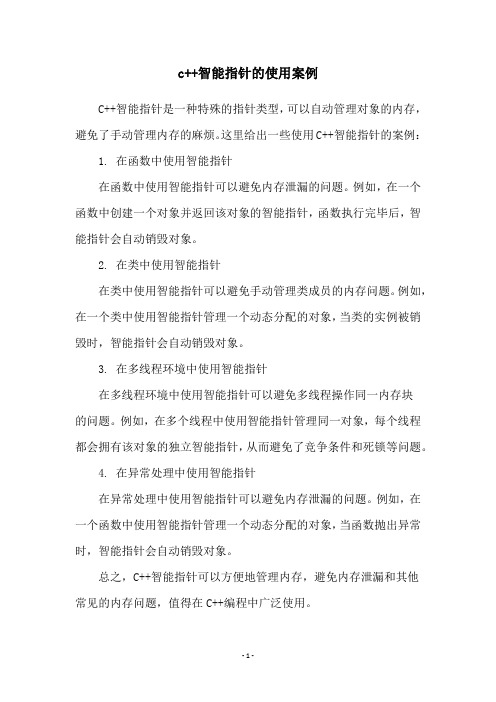
c++智能指针的使用案例
C++智能指针是一种特殊的指针类型,可以自动管理对象的内存,避免了手动管理内存的麻烦。
这里给出一些使用C++智能指针的案例: 1. 在函数中使用智能指针
在函数中使用智能指针可以避免内存泄漏的问题。
例如,在一个函数中创建一个对象并返回该对象的智能指针,函数执行完毕后,智能指针会自动销毁对象。
2. 在类中使用智能指针
在类中使用智能指针可以避免手动管理类成员的内存问题。
例如,在一个类中使用智能指针管理一个动态分配的对象,当类的实例被销毁时,智能指针会自动销毁对象。
3. 在多线程环境中使用智能指针
在多线程环境中使用智能指针可以避免多线程操作同一内存块
的问题。
例如,在多个线程中使用智能指针管理同一对象,每个线程都会拥有该对象的独立智能指针,从而避免了竞争条件和死锁等问题。
4. 在异常处理中使用智能指针
在异常处理中使用智能指针可以避免内存泄漏的问题。
例如,在一个函数中使用智能指针管理一个动态分配的对象,当函数抛出异常时,智能指针会自动销毁对象。
总之,C++智能指针可以方便地管理内存,避免内存泄漏和其他
常见的内存问题,值得在C++编程中广泛使用。
- 1 -。
函数参数智能指针
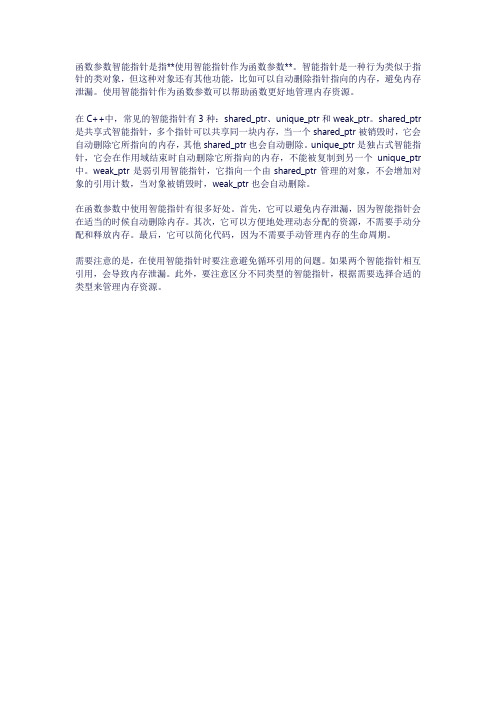
函数参数智能指针是指**使用智能指针作为函数参数**。
智能指针是一种行为类似于指针的类对象,但这种对象还有其他功能,比如可以自动删除指针指向的内存,避免内存泄漏。
使用智能指针作为函数参数可以帮助函数更好地管理内存资源。
在C++中,常见的智能指针有3种:shared_ptr、unique_ptr和weak_ptr。
shared_ptr 是共享式智能指针,多个指针可以共享同一块内存,当一个shared_ptr被销毁时,它会自动删除它所指向的内存,其他shared_ptr也会自动删除。
unique_ptr是独占式智能指针,它会在作用域结束时自动删除它所指向的内存,不能被复制到另一个unique_ptr 中。
weak_ptr是弱引用智能指针,它指向一个由shared_ptr管理的对象,不会增加对象的引用计数,当对象被销毁时,weak_ptr也会自动删除。
在函数参数中使用智能指针有很多好处。
首先,它可以避免内存泄漏,因为智能指针会在适当的时候自动删除内存。
其次,它可以方便地处理动态分配的资源,不需要手动分配和释放内存。
最后,它可以简化代码,因为不需要手动管理内存的生命周期。
需要注意的是,在使用智能指针时要注意避免循环引用的问题。
如果两个智能指针相互引用,会导致内存泄漏。
此外,要注意区分不同类型的智能指针,根据需要选择合适的类型来管理内存资源。
函数参数智能指针
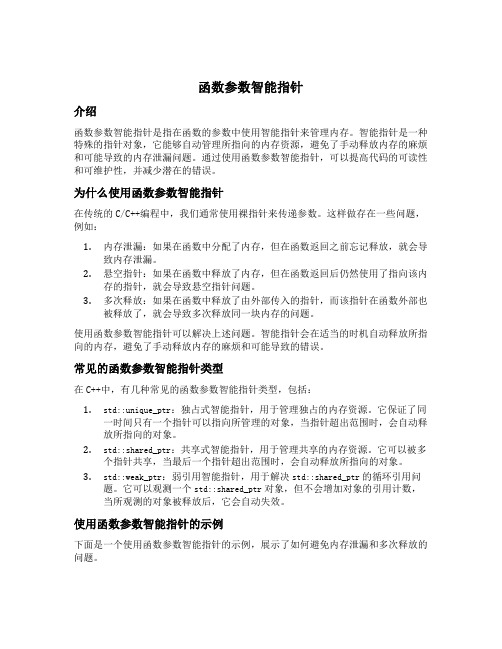
函数参数智能指针介绍函数参数智能指针是指在函数的参数中使用智能指针来管理内存。
智能指针是一种特殊的指针对象,它能够自动管理所指向的内存资源,避免了手动释放内存的麻烦和可能导致的内存泄漏问题。
通过使用函数参数智能指针,可以提高代码的可读性和可维护性,并减少潜在的错误。
为什么使用函数参数智能指针在传统的C/C++编程中,我们通常使用裸指针来传递参数。
这样做存在一些问题,例如:1.内存泄漏:如果在函数中分配了内存,但在函数返回之前忘记释放,就会导致内存泄漏。
2.悬空指针:如果在函数中释放了内存,但在函数返回后仍然使用了指向该内存的指针,就会导致悬空指针问题。
3.多次释放:如果在函数中释放了由外部传入的指针,而该指针在函数外部也被释放了,就会导致多次释放同一块内存的问题。
使用函数参数智能指针可以解决上述问题。
智能指针会在适当的时机自动释放所指向的内存,避免了手动释放内存的麻烦和可能导致的错误。
常见的函数参数智能指针类型在C++中,有几种常见的函数参数智能指针类型,包括:1.std::unique_ptr:独占式智能指针,用于管理独占的内存资源。
它保证了同一时间只有一个指针可以指向所管理的对象,当指针超出范围时,会自动释放所指向的对象。
2.std::shared_ptr:共享式智能指针,用于管理共享的内存资源。
它可以被多个指针共享,当最后一个指针超出范围时,会自动释放所指向的对象。
3.std::weak_ptr:弱引用智能指针,用于解决std::shared_ptr的循环引用问题。
它可以观测一个std::shared_ptr对象,但不会增加对象的引用计数,当所观测的对象被释放后,它会自动失效。
使用函数参数智能指针的示例下面是一个使用函数参数智能指针的示例,展示了如何避免内存泄漏和多次释放的问题。
#include <iostream>#include <memory>void process_data(std::unique_ptr<int> data) {// 在这里对data进行一些处理std::cout << "Data: " << *data << std::endl;}int main() {std::unique_ptr<int> data(new int(10));process_data(std::move(data));// 在这里无需手动释放data指向的内存return 0;}在上面的示例中,我们使用了std::unique_ptr来管理data指向的内存。
全的C语言指针详解PPT课件

在函数中使用指针参数
03
使用指针参数来访问和修改指针所指向的内容,需要使用“-
>”或“*”运算符。
05
指针的高级应用
指向指针的指针(二级指针)
定义与声明
二级指针是用来存储另一个指 针的地址的指针。在声明时, 需要使用`*`操作符来声明二级
指针。
初始化与使用
通过使用`&`操作符获取一个指 针的地址,并将该地址存储在 二级指针中。然后,可以通过 二级指针来访问和操作原始指
当使用malloc或calloc等函 数动态分配内存后,如果 不再需要该内存,必须使 用free函数释放它。否则, 指针将指向一个无效的内 存地址。
当一个指针在函数中定义 ,但该函数返回后仍然存 在并继续指向无效的内存 地址时,就会产生野指针 。
避免指针越界访问
总结词:指针越界访问是指试图访问数 组之外的内存,这是不安全的,可能会 导致程序崩溃或产生不可预测的结果。
指针与内存分配
通过指针来访问和操作动态分配的内存空间。指针可以 存储动态分配的内存地址,并用于读取和写入该地址中 的数据。
指向结构体的指针
01
定义与声明
指向结构体的指针是指向结构体类型的指针。在声明时,需要使用结
构体类型的名称来声明指向结构体的指针。
02 03
初始化与使用
通过使用`&`操作符获取结构体的地址,并将该地址存储在指向结构 体的指针中。然后,可以通过该指针来访问和操作结构体中的成员变 量。
```
பைடு நூலகம்
指向数组元素的指针
• 指向数组元素的指针是指向数组中某个具体元素的指针。通过将指针指向数组中的某个元素,可以访问该 元素的值。
• 指向数组元素的指针可以通过定义一个指向具体元素的指针来实现。例如,定义一个指向数组中第三个元 素的指针,可以使用以下代码
c++ 智能指针计数原理
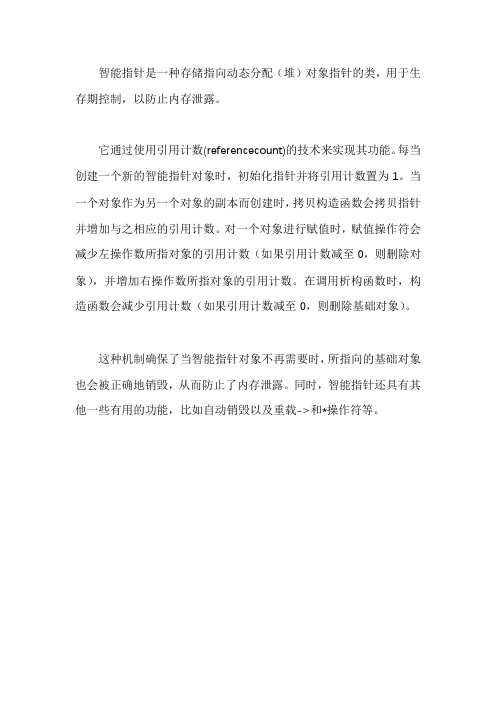
智能指针是一种存储指向动态分配(堆)对象指针的类,用于生存期控制,以防止内存泄露。
它通过使用引用计数(referencecount)的技术来实现其功能。
每当创建一个新的智能指针对象时,初始化指针并将引用计数置为1。
当一个对象作为另一个对象的副本而创建时,拷贝构造函数会拷贝指针并增加与之相应的引用计数。
对一个对象进行赋值时,赋值操作符会减少左操作数所指对象的引用计数(如果引用计数减至0,则删除对象),并增加右操作数所指对象的引用计数。
在调用析构函数时,构造函数会减少引用计数(如果引用计数减至0,则删除基础对象)。
这种机制确保了当智能指针对象不再需要时,所指向的基础对象也会被正确地销毁,从而防止了内存泄露。
同时,智能指针还具有其他一些有用的功能,比如自动销毁以及重载->和*操作符等。
C语言指针详细讲解

类型转换错误
01 总结词
类型转换错误是指试图将一个类型的指针 转换为另一个类型,导致程序崩溃或未定 义行为。
02 详细描述
类型转换错误通常发生在以下情况
03
1. 强制类型转换
04
强制类型转换是一种不安全的操作,它可能 会导致内存访问错误或程序崩溃。例如,将 一个int类型的指针强制转换为char类型的 指针,然后试图访问该地址,可能会导致程 序崩溃。
指向void的指针的使用
01
什么是指向void的指针
指向void的指针是一个特殊类型的指针,它可以指向任何类型的数据,
但是不能直接对其进行操作。
02
为何使用指向void的指针
使用指向void的指针可以在不知道指针所指向的数据类型的情况下,传
递数据或函数的参数。
03
如何使用指向void的指针
在C语言中,可以使用void关键字定义一个指向void的指针。例如:
3
在C语言中,指针变量通常用"*"表示其类型。
指针的类型
指针的类型取决于它所指向的变量的类型。 如果指针指向一个浮点数,则该指针的类型为float *。
如果指针指向一个整数,则该指针的类型为int *。 如果指针指向一个字符,则该指针的类型为char *。
指针的变量
指针变量可以声明为任何类型,包括int 、float、char等。
c语言指针详细讲解
汇报人: 日期:
目 录
• c语言指针基本概念 • c语言指针的运算 • c语言指针与数组 • c语言指针与函数 • c语言指针的使用技巧与注意事项 • c语言指针常见错误分析
01
c语言指针基本概念
指针的定义
C++中的智能指针和内存管理
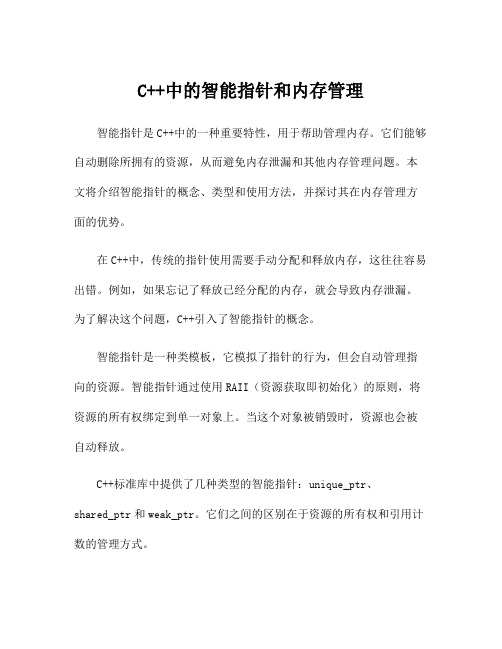
C++中的智能指针和内存管理智能指针是C++中的一种重要特性,用于帮助管理内存。
它们能够自动删除所拥有的资源,从而避免内存泄漏和其他内存管理问题。
本文将介绍智能指针的概念、类型和使用方法,并探讨其在内存管理方面的优势。
在C++中,传统的指针使用需要手动分配和释放内存,这往往容易出错。
例如,如果忘记了释放已经分配的内存,就会导致内存泄漏。
为了解决这个问题,C++引入了智能指针的概念。
智能指针是一种类模板,它模拟了指针的行为,但会自动管理指向的资源。
智能指针通过使用RAII(资源获取即初始化)的原则,将资源的所有权绑定到单一对象上。
当这个对象被销毁时,资源也会被自动释放。
C++标准库中提供了几种类型的智能指针:unique_ptr、shared_ptr和weak_ptr。
它们之间的区别在于资源的所有权和引用计数的管理方式。
unique_ptr是一种独占的智能指针,它以独占的方式拥有所指向的对象。
它的特点是在任何时候只有一个unique_ptr可以拥有特定的对象。
当unique_ptr被销毁时,它所拥有的资源也会被释放。
这个特性确保了资源不会被多个指针同时访问,从而避免了悬空指针和内存泄漏的问题。
shared_ptr是一种共享的智能指针,可以允许多个shared_ptr拥有同一个对象。
它使用引用计数的方式管理资源的生命周期。
每当有新的shared_ptr指向一个对象时,引用计数会增加;当没有任何shared_ptr指向对象时,引用计数会减少。
当引用计数降为零时,对象所占用的内存会被释放。
shared_ptr的好处是可以避免多个指针同时释放同一个资源,并且可以跨函数和线程进行传递。
weak_ptr是shared_ptr的一种扩展,它可以避免循环引用导致的内存泄漏问题。
当存在互相引用的shared_ptr时,它们之间的循环引用可能会导致资源无法释放。
为了解决这个问题,可以使用weak_ptr 来建立一个弱引用。
c++智能指针的工作原理

c++智能指针的工作原理
C++智能指针是一种用于管理动态分配的内存的工具。
它们可
以自动进行内存管理,以避免内存泄漏和重复释放的问题。
C++标准库中提供了两种智能指针:std::shared_ptr和
std::unique_ptr。
1. std::shared_ptr:
- 智能指针使用引用计数的方法来管理内存。
它们会记录有
多少个智能指针指向同一块内存。
- 当创建一个std::shared_ptr时,引用计数初始化为1。
- 每次复制或移动std::shared_ptr时,引用计数会递增。
- 当智能指针超出其作用域或被重新分配时,引用计数会递减。
- 当引用计数变为0时,智能指针会自动销毁所管理的内存。
2. std::unique_ptr:
- 智能指针使用独占所有权的方法来管理内存。
它们不允许
多个指针同时指向相同的内存。
- 当创建一个std::unique_ptr时,它会获取对所管理的内存的
独占所有权。
- std::unique_ptr不支持复制,只能通过移动来传递所有权。
- 当智能指针超出其作用域时,它会自动销毁所管理的内存。
无论是std::shared_ptr还是std::unique_ptr,当智能指针超出其
作用域或被重新分配时,它们所管理的内存都会被自动释放。
这样可以避免手动释放内存、内存泄漏和重复释放的问题,提高了代码的可靠性和可维护性。
【转】C++智能指针的正确使用方式
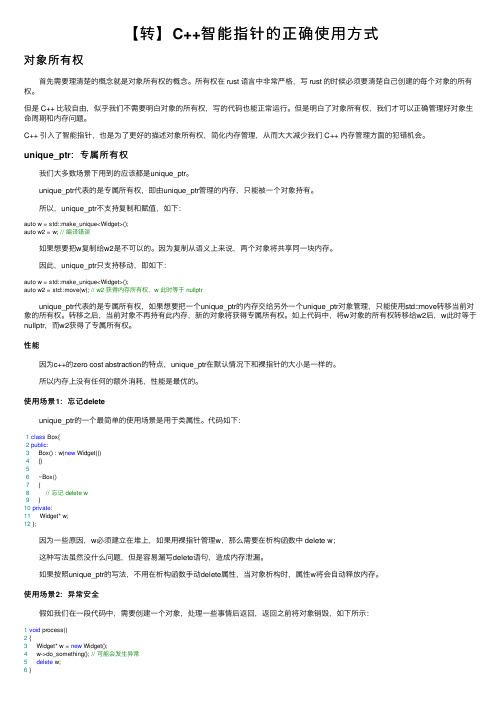
【转】C++智能指针的正确使⽤⽅式对象所有权 ⾸先需要理清楚的概念就是对象所有权的概念。
所有权在 rust 语⾔中⾮常严格,写 rust 的时候必须要清楚⾃⼰创建的每个对象的所有权。
但是 C++ ⽐较⾃由,似乎我们不需要明⽩对象的所有权,写的代码也能正常运⾏。
但是明⽩了对象所有权,我们才可以正确管理好对象⽣命周期和内存问题。
C++ 引⼊了智能指针,也是为了更好的描述对象所有权,简化内存管理,从⽽⼤⼤减少我们 C++ 内存管理⽅⾯的犯错机会。
unique_ptr:专属所有权 我们⼤多数场景下⽤到的应该都是unique_ptr。
unique_ptr代表的是专属所有权,即由unique_ptr管理的内存,只能被⼀个对象持有。
所以,unique_ptr不⽀持复制和赋值,如下:auto w = std::make_unique<Widget>();auto w2 = w; // 编译错误 如果想要把w复制给w2是不可以的。
因为复制从语义上来说,两个对象将共享同⼀块内存。
因此,unique_ptr只⽀持移动,即如下:auto w = std::make_unique<Widget>();auto w2 = std::move(w); // w2 获得内存所有权,w 此时等于 nullptr unique_ptr代表的是专属所有权,如果想要把⼀个unique_ptr的内存交给另外⼀个unique_ptr对象管理,只能使⽤std::move转移当前对象的所有权。
转移之后,当前对象不再持有此内存,新的对象将获得专属所有权。
如上代码中,将w对象的所有权转移给w2后,w此时等于nullptr,⽽w2获得了专属所有权。
性能 因为c++的zero cost abstraction的特点,unique_ptr在默认情况下和裸指针的⼤⼩是⼀样的。
所以内存上没有任何的额外消耗,性能是最优的。
使⽤场景1:忘记delete unique_ptr的⼀个最简单的使⽤场景是⽤于类属性。
C++11unique_ptr智能指针详解

C++11unique_ptr智能指针详解在《》的基础上,本节继续讲解 C++11 标准提供的另⼀种智能指针,即 unique_ptr 智能指针。
作为智能指针的⼀种,unique_ptr 指针⾃然也具备“在适当时机⾃动释放堆内存空间”的能⼒。
和 shared_ptr 指针最⼤的不同之处在于,unique_ptr 指针指向的堆内存⽆法同其它 unique_ptr 共享,也就是说,每个 unique_ptr 指针都独⾃拥有对其所指堆内存空间的所有权。
这也就意味着,每个 unique_ptr 指针指向的堆内存空间的引⽤计数,都只能为 1,⼀旦该 unique_ptr 指针放弃对所指堆内存空间的所有权,则该空间会被⽴即释放回收。
unique_ptr 智能指针是以模板类的形式提供的,unique_ptr<T>(T 为指针所指数据的类型)定义在<memory>头⽂件,并位于 std 命名空间中。
因此,要想使⽤ unique_ptr 类型指针,程序中应⾸先包含如下 2 条语句:1. #include <memory>2. using namespace std;第 2 句并不是必须的,可以不添加,则后续在使⽤ unique_ptr 指针时,必须标注std::。
unique_ptr智能指针的创建考虑到不同实际场景的需要,unique_ptr<T> 模板类提供了多个实⽤的构造函数,这⾥给读者列举了⼏种常⽤的构造 unique_ptr 智能指针的⽅式。
1) 通过以下 2 种⽅式,可以创建出空的 unique_ptr 指针:1. std::unique_ptr<int> p1();2. std::unique_ptr<int> p2(nullptr);2) 创建 unique_ptr 指针的同时,也可以明确其指向。
例如:1. std::unique_ptr<int> p3(new int);由此就创建出了⼀个 p3 智能指针,其指向的是可容纳 1 个整数的堆存储空间。
c++智能指针和析构函数
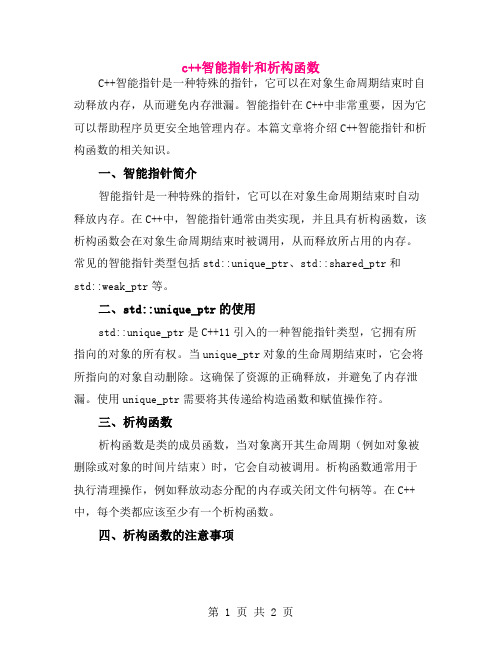
c++智能指针和析构函数C++智能指针是一种特殊的指针,它可以在对象生命周期结束时自动释放内存,从而避免内存泄漏。
智能指针在C++中非常重要,因为它可以帮助程序员更安全地管理内存。
本篇文章将介绍C++智能指针和析构函数的相关知识。
一、智能指针简介智能指针是一种特殊的指针,它可以在对象生命周期结束时自动释放内存。
在C++中,智能指针通常由类实现,并且具有析构函数,该析构函数会在对象生命周期结束时被调用,从而释放所占用的内存。
常见的智能指针类型包括std::unique_ptr、std::shared_ptr和std::weak_ptr等。
二、std::unique_ptr的使用std::unique_ptr是C++11引入的一种智能指针类型,它拥有所指向的对象的所有权。
当unique_ptr对象的生命周期结束时,它会将所指向的对象自动删除。
这确保了资源的正确释放,并避免了内存泄漏。
使用unique_ptr需要将其传递给构造函数和赋值操作符。
三、析构函数析构函数是类的成员函数,当对象离开其生命周期(例如对象被删除或对象的时间片结束)时,它会自动被调用。
析构函数通常用于执行清理操作,例如释放动态分配的内存或关闭文件句柄等。
在C++中,每个类都应该至少有一个析构函数。
四、析构函数的注意事项1. 析构函数的访问级别通常为private,以确保只有类的成员函数可以调用析构函数。
这有助于防止在类的实例被删除之前调用析构函数,从而导致未定义的行为。
2. 析构函数的名称应该以波浪号(~)开头,以指示它是一个析构函数。
这有助于编译器在编译时检测可能的错误。
3. 析构函数的参数列表可以为空,但通常不需要传递任何参数。
如果需要传递参数,应该使用const引用或指针类型,以避免在析构函数中修改对象的状态。
4. 析构函数的返回类型通常为void或无返回类型。
返回值可以忽略或不实际使用,因为它不应该在析构函数中使用。
五、使用智能指针时的注意事项在使用智能指针时,需要小心处理异常和并发访问的情况。
C++11智能指针之weak_ptr详解
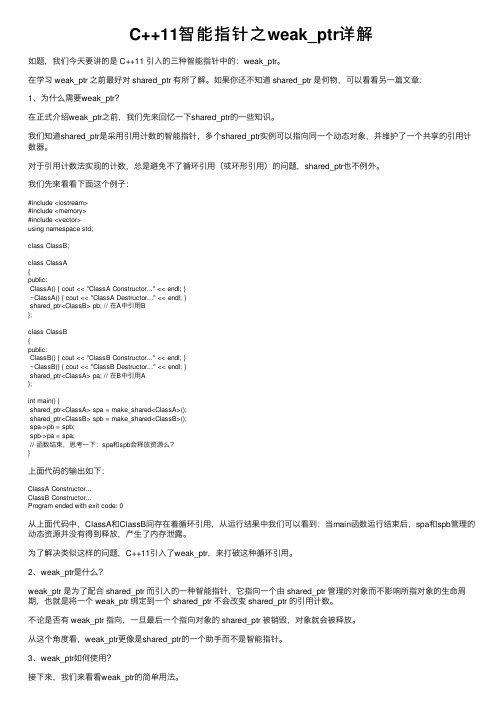
C++11智能指针之weak_ptr详解如题,我们今天要讲的是 C++11 引⼊的三种智能指针中的:weak_ptr。
在学习 weak_ptr 之前最好对 shared_ptr 有所了解。
如果你还不知道 shared_ptr 是何物,可以看看另⼀篇⽂章:1、为什么需要weak_ptr?在正式介绍weak_ptr之前,我们先来回忆⼀下shared_ptr的⼀些知识。
我们知道shared_ptr是采⽤引⽤计数的智能指针,多个shared_ptr实例可以指向同⼀个动态对象,并维护了⼀个共享的引⽤计数器。
对于引⽤计数法实现的计数,总是避免不了循环引⽤(或环形引⽤)的问题,shared_ptr也不例外。
我们先来看看下⾯这个例⼦:#include <iostream>#include <memory>#include <vector>using namespace std;class ClassB;class ClassA{public:ClassA() { cout << "ClassA Constructor..." << endl; }~ClassA() { cout << "ClassA Destructor..." << endl; }shared_ptr<ClassB> pb; // 在A中引⽤B};class ClassB{public:ClassB() { cout << "ClassB Constructor..." << endl; }~ClassB() { cout << "ClassB Destructor..." << endl; }shared_ptr<ClassA> pa; // 在B中引⽤A};int main() {shared_ptr<ClassA> spa = make_shared<ClassA>();shared_ptr<ClassB> spb = make_shared<ClassB>();spa->pb = spb;spb->pa = spa;// 函数结束,思考⼀下:spa和spb会释放资源么?}上⾯代码的输出如下:ClassA Constructor...ClassB Constructor...Program ended with exit code: 0从上⾯代码中,ClassA和ClassB间存在着循环引⽤,从运⾏结果中我们可以看到:当main函数运⾏结束后,spa和spb管理的动态资源并没有得到释放,产⽣了内存泄露。
c语言指针用法详解,通俗易懂超详细!

c语言指针用法详解一、什么是指针?在学习C语言时,指针是一个非常重要且常见的概念。
所谓指针,就是指向内存位置区域的变量,它能够提供内存位置区域的直接访问。
在C语言中,使用指针可以对内存中的数据进行直接的访问和操作,因此掌握指针的用法对于编程非常重要。
二、指针的声明和初始化在C语言中,指针的声明和初始化非常简单,通常的格式为:数据类型 *指针变量名;例如:int *p;这样就声明了一个指向整型数据的指针变量p。
指针变量的初始化可以通过取位置区域操作符,将某个变量的位置区域赋值给指针变量;例如:int a = 10;int *p = a;这样p就指向了变量a的位置区域。
三、指针的应用1. 通过指针访问变量通过指针可以直接访问变量的数值,即通过指针来操作变量。
例如:int a = 10;int *p = a;*p = 20;这样就通过指针p修改了变量a 的数值为20。
2. 指针和数组在C语言中,数组名本身就是一个常量指针,它指向数组的首位置区域。
通过指针可以对数组进行遍历和操作,实现对数组元素的访问和修改。
3. 指针和函数指针和函数结合使用可以实现函数间的数据传递和数据共享。
通过指针可以将变量的位置区域传递给函数,由函数直接对变量进行操作,从而实现数据的共享和修改。
四、指针的优势和注意事项1. 优势:指针能够直接访问内存位置区域,可以对数据进行直接的操作,提高了程序的灵活性和效率。
2. 注意事项:由于指针直接操作内存,因此在使用指针时需要特别小心,避免出现空指针、野指针等问题,以免引起程序的崩溃和错误。
五、总结回顾通过本文的介绍,我们对C语言指针的用法有了更深入的了解。
指针作为C语言中非常重要的概念,掌握其用法对于编程至关重要。
通过本文的学习,我们可以更加灵活地应用指针来操作变量、数组和函数,提高程序的效率和灵活性。
六、个人观点和理解对我而言,指针是C语言中最重要的概念之一。
通过学习和使用指针,我能够更加灵活地操作内存中的数据,同时也要特别小心避免指针操作中可能出现的问题。
C++智能指针用法详解

C++智能指针⽤法详解⼀、简介由于 C++ 语⾔没有⾃动内存回收机制,程序员每次 new 出来的内存都要⼿动 delete。
程序员忘记 delete,流程太复杂,最终导致没有delete,异常导致程序过早退出,没有执⾏ delete 的情况并不罕见。
⽤智能指针便可以有效缓解这类问题,本⽂主要讲解常见的智能指针的⽤法。
包括:std::auto_ptr、boost::scoped_ptr、boost::shared_ptr、boost::scoped_array、boost::shared_array、boost::weak_ptr、boost:: intrusive_ptr。
你可能会想,如此多的智能指针就为了解决new、delete匹配问题,真的有必要吗?看完这篇⽂章后,我想你⼼⾥⾃然会有答案。
下⾯就按照顺序讲解如上 7 种智能指针(smart_ptr)。
⼆、具体使⽤1、总括(1)对于编译器来说,智能指针实际上是⼀个栈对象,并⾮指针类型,在栈对象⽣命期即将结束时,智能指针通过析构函数释放由它管理的堆内存;(2)所有智能指针都重载了“operator->”操作符,直接返回对象的引⽤,⽤以操作对象(参见);(3)访问智能指针原来的⽅法则使⽤“.”操作符;(4)访问智能指针包含的裸指针则可以⽤ get() 函数;(5)由于智能指针是⼀个对象,所以if (my_smart_object)永远为真,要判断智能指针的裸指针是否为空,需要这样判断:if(my_smart_object.get())。
(6)智能指针包含了 reset() ⽅法,如果不传递参数(或者传递 NULL),则智能指针会释放当前管理的内存。
如果传递⼀个对象,则智能指针会释放当前对象,来管理新传⼊的对象。
⾸先,我们编写⼀个测试类来辅助分析:class Simple {public:Simple(int param = 0){number = param;std::cout << "Simple: " << number << std::endl;}~Simple(){std::cout << "~Simple: " << number << std::endl;}void PrintSomething(){std::cout << "PrintSomething: " << info_extend.c_str() << std::endl;}std::string info_extend;int number;};2、std::auto_ptr——独占(《C++ Primer Plus》(第六版)中还有提及std::unique_ptr)std::auto_ptr 属于 STL,当然在 namespace std 中,包含头⽂件 #include<memory>便可以使⽤。
C内存管理智能指针与RAII的应用

C内存管理智能指针与RAII的应用C语言是一门强大而受欢迎的编程语言,但它也因为缺乏自动内存管理而给开发者带来了很多困扰。
为了解决这一问题,C++引入了智能指针和资源获取即初始化(RAII)的概念。
在本文中,我们将讨论C 内存管理中智能指针和RAII的应用。
1. 智能指针的概念与使用智能指针是一个类模板,用于管理动态分配的内存。
它重载了指针操作符,能够像原始指针一样访问对象,同时在对象不再需要时自动释放所占用的内存。
在C++中,智能指针的典型代表是std::unique_ptr 和std::shared_ptr。
在C内存管理中,我们可以借鉴智能指针的概念来实现内存的自动管理。
通过定义一个结构体或者类来封装原始指针,并在析构函数中释放内存,我们可以实现类似于智能指针的功能。
下面是一个使用智能指针的例子:```c#include <stdio.h>#include <stdlib.h>typedef struct {int *data;} SmartPointer;SmartPointer *createSmartPointer(int value) {SmartPointer *sp = (SmartPointer *)malloc(sizeof(SmartPointer)); sp->data = (int *)malloc(sizeof(int));*(sp->data) = value;return sp;}void destroySmartPointer(SmartPointer *sp) {free(sp->data);free(sp);}int main() {SmartPointer *sp = createSmartPointer(10);printf("%d\n", *(sp->data));destroySmartPointer(sp);return 0;}```在这个例子中,我们使用一个SmartPoint结构体来封装原始指针,并在创建结构体时动态分配内存。
C++智能指针使用说明
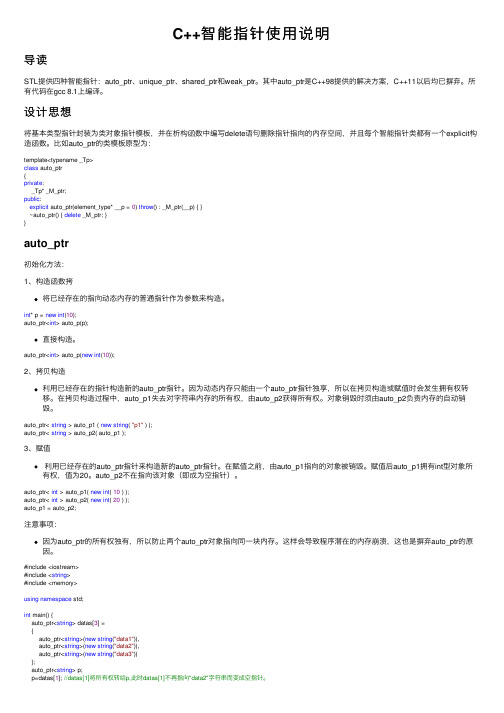
C++智能指针使⽤说明导读STL提供四种智能指针:auto_ptr、unique_ptr、shared_ptr和weak_ptr。
其中auto_ptr是C++98提供的解决⽅案,C++11以后均已摒弃。
所有代码在gcc 8.1上编译。
设计思想将基本类型指针封装为类对象指针模板,并在析构函数中编写delete语句删除指针指向的内存空间,并且每个智能指针类都有⼀个explicit构造函数。
⽐如auto_ptr的类模板原型为:template<typename _Tp>class auto_ptr{private:_Tp* _M_ptr;public:explicit auto_ptr(element_type* __p = 0) throw() : _M_ptr(__p) { }~auto_ptr() { delete _M_ptr; }}auto_ptr初始化⽅法:1、构造函数拷将已经存在的指向动态内存的普通指针作为参数来构造。
int* p = new int(10);auto_ptr<int> auto_p(p);直接构造。
auto_ptr<int> auto_p(new int(10));2、拷贝构造利⽤已经存在的指针构造新的auto_ptr指针。
因为动态内存只能由⼀个auto_ptr指针独享,所以在拷贝构造或赋值时会发⽣拥有权转移。
在拷贝构造过程中,auto_p1失去对字符串内存的所有权,由auto_p2获得所有权。
对象销毁时须由auto_p2负责内存的⾃动销毁。
auto_ptr< string > auto_p1 ( new string( "p1" ) );auto_ptr< string > auto_p2( auto_p1 );3、赋值利⽤已经存在的auto_ptr指针来构造新的auto_ptr指针。
在赋值之前,由auto_p1指向的对象被销毁。
c++中智能指针的用法
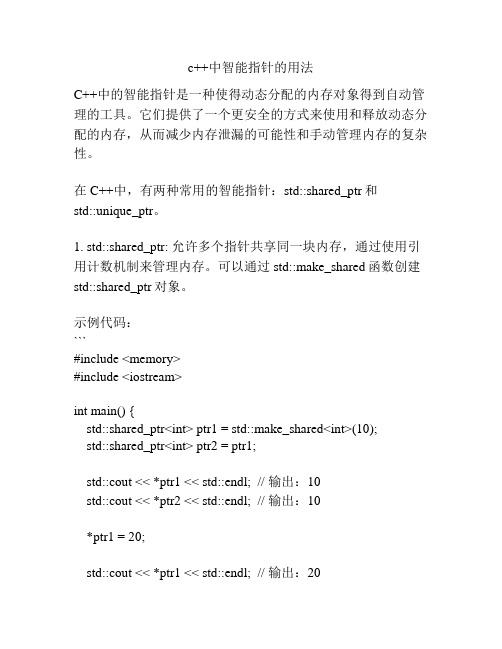
c++中智能指针的用法C++中的智能指针是一种使得动态分配的内存对象得到自动管理的工具。
它们提供了一个更安全的方式来使用和释放动态分配的内存,从而减少内存泄漏的可能性和手动管理内存的复杂性。
在C++中,有两种常用的智能指针:std::shared_ptr和std::unique_ptr。
1. std::shared_ptr: 允许多个指针共享同一块内存,通过使用引用计数机制来管理内存。
可以通过std::make_shared函数创建std::shared_ptr对象。
示例代码:```#include <memory>#include <iostream>int main() {std::shared_ptr<int> ptr1 = std::make_shared<int>(10);std::shared_ptr<int> ptr2 = ptr1;std::cout << *ptr1 << std::endl; // 输出:10std::cout << *ptr2 << std::endl; // 输出:10*ptr1 = 20;std::cout << *ptr1 << std::endl; // 输出:20std::cout << *ptr2 << std::endl; // 输出:20return 0;}```2. std::unique_ptr: 在任意时刻,只能有一个std::unique_ptr指向同一块内存,通过使用移动语义来传递所有权。
可以通过std::make_unique函数创建std::unique_ptr对象。
示例代码:```#include <memory>#include <iostream>int main() {std::unique_ptr<int> ptr1 = std::make_unique<int>(10);// std::unique_ptr<int> ptr2 = ptr1; // 错误:无法进行复制std::cout << *ptr1 << std::endl; // 输出:10*ptr1 = 20;std::cout << *ptr1 << std::endl; // 输出:20return 0;}```使用智能指针可以避免手动调用delete释放内存,因为智能指针会在其生命周期结束时自动释放内存。
智能指针auto_ptr详解

智能指针auto_ptr详解1. 智能指针auto_ptr的引⼊auto_ptr是C++标准库中的智能指针模板类,头⽂件<memory>auto_ptr的出现,主要是为了解决“有异常抛出时发⽣内存泄漏”的问题。
如下的简单代码是这类问题的⼀个简单⽰例。
int* p = new int(100);try{doSomething();cout << *p << endl;delete p;}catch(exception& e){}当doSomething();部分抛出异常,将导致指针p所指向的空间得不到释放⽽导致内存泄露。
auto_ptr的引⼊解决了这类问题。
2. auto_ptr的源代码(未可读性进⾏了少许改动的源码)1namespace std2 {3 template<class T>4class auto_ptr5 {6private:7 T* ap;8public:910// constructor & destructor ----------------------------------- (1)11explicit auto_ptr (T* ptr = 0) throw() : ap(ptr){}1213 ~auto_ptr() throw()14 {15 delete ap;16 }171819// Copy & assignment --------------------------------------------(2)20 auto_ptr (auto_ptr& rhs) throw() :ap(rhs.release()) {}21 template<class Y>22 auto_ptr (auto_ptr<Y>& rhs) throw() : ap(rhs.release()) { }2324 auto_ptr& operator= (auto_ptr& rhs) throw()25 {26 reset(rhs.release());27return *this;28 }29 template<class Y>30 auto_ptr& operator= (auto_ptr<Y>& rhs) throw()31 {32 reset(rhs.release());33return *this;34 }3536// Dereference----------------------------------------------------(3)37 T& operator*() const throw()38 {39return *ap;40 }41 T* operator->() const throw()42 {43return ap;44 }4546// Helper functions------------------------------------------------(4)47// value access48 T* get() const throw()49 {50return ap;51 }5253// release ownership54 T* release() throw()55 {56 T* tmp(ap);57 ap = 0;58return tmp;59 }6061// reset value62void reset (T* ptr=0) throw()63 {64if (ap != ptr)65 {66 delete ap;67 ap = ptr;68 }69 }7071// Special conversions-----------------------------------------------(5)72 template<class Y>73struct auto_ptr_ref74 {75 Y* yp;76 auto_ptr_ref (Y* rhs) : yp(rhs) {}77 };7879 auto_ptr(auto_ptr_ref<T> rhs) throw() : ap(rhs.yp) { }80 auto_ptr& operator= (auto_ptr_ref<T> rhs) throw()81 {82 reset(rhs.yp);83return *this;84 }85 template<class Y>86operator auto_ptr_ref<Y>() throw()87 {88return auto_ptr_ref<Y>(release());89 }90 template<class Y>91operator auto_ptr<Y>() throw()92 {93return auto_ptr<Y>(release());94 }95 };96 }3. auto_ptr的使⽤3.1 创建auto_ptr对象auto_ptr构造时取得某个对象的所有权,在析构时释放该对象。
- 1、下载文档前请自行甄别文档内容的完整性,平台不提供额外的编辑、内容补充、找答案等附加服务。
- 2、"仅部分预览"的文档,不可在线预览部分如存在完整性等问题,可反馈申请退款(可完整预览的文档不适用该条件!)。
- 3、如文档侵犯您的权益,请联系客服反馈,我们会尽快为您处理(人工客服工作时间:9:00-18:30)。
C++ 智能指针详解一、简介由于 C++ 语言没有自动内存回收机制,程序员每次 new 出来的内存都要手动 delete。
程序员忘记 delete,流程太复杂,最终导致没有 delete,异常导致程序过早退出,没有执行 delete 的情况并不罕见。
用智能指针便可以有效缓解这类问题,本文主要讲解参见的智能指针的用法。
包括:std::auto_ptr、boost::scoped_ptr、boost::shared_ptr、boost::scoped_array、boost::shared_array、boost::weak_ptr、boost::intrusive_ptr。
你可能会想,如此多的智能指针就为了解决new、delete 匹配问题,真的有必要吗?看完这篇文章后,我想你心里自然会有答案。
下面就按照顺序讲解如上 7 种智能指针(smart_ptr)。
二、具体使用1、总括对于编译器来说,智能指针实际上是一个栈对象,并非指针类型,在栈对象生命期即将结束时,智能指针通过析构函数释放有它管理的堆内存。
所有智能指针都重载了“operator->”操作符,直接返回对象的引用,用以操作对象。
访问智能指针原来的方法则使用“.”操作符。
访问智能指针包含的裸指针则可以用 get() 函数。
由于智能指针是一个对象,所以if (my_smart_object)永远为真,要判断智能指针的裸指针是否为空,需要这样判断:if (my_smart_object.get())。
智能指针包含了 reset() 方法,如果不传递参数(或者传递 NULL),则智能指针会释放当前管理的内存。
如果传递一个对象,则智能指针会释放当前对象,来管理新传入的对象。
我们编写一个测试类来辅助分析:class Simple {public:Simple(int param = 0) {number = param;std::cout << "Simple: " << number << std::endl;}~Simple() {std::cout << "~Simple: " << number << std::endl;}void PrintSomething() {std::cout << "PrintSomething: " << info_extend.c_str() << std::endl;}std::string info_extend;int number;};2、std::auto_ptrstd::auto_ptr 属于 STL,当然在 namespace std 中,包含头文件 #include<memory> 便可以使用。
std::auto_ptr 能够方便的管理单个堆内存对象。
我们从代码开始分析:void TestAutoPtr() {std::auto_ptr<Simple> my_memory(new Simple(1)); // 创建对象,输出:Simple:1if (my_memory.get()) { // 判断智能指针是否为空my_memory->PrintSomething(); // 使用 operator-> 调用智能指针对象中的函数my_memory.get()->info_extend = "Addition"; // 使用 get() 返回裸指针,然后给内部对象赋值my_memory->PrintSomething(); // 再次打印,表明上述赋值成功(*my_memory).info_extend += " other"; // 使用 operator* 返回智能指针内部对象,然后用“.”调用智能指针对象中的函数my_memory->PrintSomething(); // 再次打印,表明上述赋值成功}} //my_memory 栈对象即将结束生命期,析构堆对象Simple(1)执行结果为:Simple: 1PrintSomething:PrintSomething: AdditionPrintSomething: Addition other~Simple: 1上述为正常使用 std::auto_ptr 的代码,一切似乎都良好,无论如何不用我们显示使用该死的delete 了。
其实好景不长,我们看看如下的另一个例子:void TestAutoPtr2() {std::auto_ptr<Simple> my_memory(new Simple(1));if (my_memory.get()) {std::auto_ptr<Simple> my_memory2; // 创建一个新的 my_memory2 对象my_memory2 = my_memory; // 复制旧的 my_memory 给 my_memory2my_memory2->PrintSomething(); // 输出信息,复制成功my_memory->PrintSomething(); // 崩溃}}最终如上代码导致崩溃,如上代码时绝对符合 C++ 编程思想的,居然崩溃了,跟进std::auto_ptr 的源码后,我们看到,罪魁祸首是“my_memory2 = my_memory”,这行代码,my_memory2 完全夺取了 my_memory 的内存管理所有权,导致 my_memory 悬空,最后使用时导致崩溃。
所以,使用 std::auto_ptr 时,绝对不能使用“operator=”操作符。
作为一个库,不允许用户使用,确没有明确拒绝[1],多少会觉得有点出乎预料。
看完 std::auto_ptr 好景不长的第一个例子后,让我们再来看一个:void TestAutoPtr3() {std::auto_ptr<Simple> my_memory(new Simple(1));if (my_memory.get()) {my_memory.release();}}执行结果为:Simple: 1看到什么异常了吗?我们创建出来的对象没有被析构,没有输出“~Simple: 1”,导致内存泄露。
当我们不想让 my_memory 继续生存下去,我们调用 release() 函数释放内存,结果却导致内存泄露(在内存受限系统中,如果my_memory占用太多内存,我们会考虑在使用完成后,立刻归还,而不是等到 my_memory 结束生命期后才归还)。
正确的代码应该为:void TestAutoPtr3() {std::auto_ptr<Simple> my_memory(new Simple(1));if (my_memory.get()) {Simple* temp_memory = my_memory.release();delete temp_memory;}}或void TestAutoPtr3() {std::auto_ptr<Simple> my_memory(new Simple(1));if (my_memory.get()) {my_memory.reset(); // 释放 my_memory 内部管理的内存}}原来 std::auto_ptr 的 release() 函数只是让出内存所有权,这显然也不符合 C++ 编程思想。
总结:std::auto_ptr 可用来管理单个对象的对内存,但是,请注意如下几点:(1)尽量不要使用“operator=”。
如果使用了,请不要再使用先前对象。
(2)记住 release() 函数不会释放对象,仅仅归还所有权。
(3)std::auto_ptr 最好不要当成参数传递(读者可以自行写代码确定为什么不能)。
(4)由于 std::auto_ptr 的“operator=”问题,有其管理的对象不能放入 std::vector 等容器中。
(5)……使用一个 std::auto_ptr 的限制还真多,还不能用来管理堆内存数组,这应该是你目前在想的事情吧,我也觉得限制挺多的,哪天一个不小心,就导致问题了。
由于 std::auto_ptr 引发了诸多问题,一些设计并不是非常符合 C++ 编程思想,所以引发了下面 boost 的智能指针,boost 智能指针可以解决如上问题。
让我们继续向下看。
3、boost::scoped_ptrboost::scoped_ptr 属于 boost 库,定义在 namespace boost 中,包含头文件#include<boost/smart_ptr.hpp> 便可以使用。
boost::scoped_ptr 跟 std::auto_ptr 一样,可以方便的管理单个堆内存对象,特别的是,boost::scoped_ptr 独享所有权,避免了 std::auto_ptr恼人的几个问题。
我们还是从代码开始分析:void TestScopedPtr() {boost::scoped_ptr<Simple> my_memory(new Simple(1));if (my_memory.get()) {my_memory->PrintSomething();my_memory.get()->info_extend = "Addition";my_memory->PrintSomething();(*my_memory).info_extend += " other";my_memory->PrintSomething();my_memory.release(); // 编译 error: scoped_ptr 没有 release 函数std::auto_ptr<Simple> my_memory2;my_memory2 = my_memory; // 编译 error: scoped_ptr 没有重载 operator=,不会导致所有权转移}}首先,我们可以看到,boost::scoped_ptr 也可以像 auto_ptr 一样正常使用。
但其没有release() 函数,不会导致先前的内存泄露问题。
其次,由于 boost::scoped_ptr 是独享所有权的,所以明确拒绝用户写“my_memory2 = my_memory”之类的语句,可以缓解 std::auto_ptr 几个恼人的问题。
